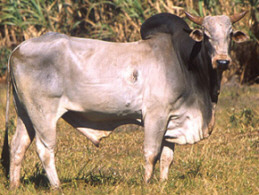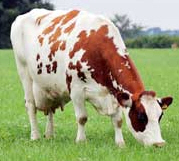



Zebu
History
Zebu cattle originated in Southwest Asia and that their descendants were non-humped, they have evolved from three breeds of Indian cattle. The Guzerat, Nelore and the Gir had most influence over Zebu breeding. Zebu cattle are humped and belong to the Bos primigenius species of cattle. They were taken to Africa at an early date and within the last 100 years, have been exported to Brazil and the US. Photo courtesy of the USDA |
During this time cross breeding of these cattle went on, Brazilian farmers that were unsure of pure bred Indian cattle used characteristics such as large ears, loose skin, the presence of a hump as an indicator of purity, both of which were common to the Gir and Guzerat not the Nelore. This cross breed were originally called Indu-Uberaba as it was developed in the region of Uberaba in the state of Minas Gerais but was then changed to Indu-Brazil. The Rinderpest was slowly eradicated and imports were resumed and the new imports of Gir, Guzerat and Nelore were used to create pure strains of the Zebu breed.
They are thought to be the worlds oldest domesticated cattle. The name Zebu today can be used as a direct name for that breed of cattle but it is also used as a general name for breeds such as Brahman, Gir, Guzera and Nelore.
Many other breeds have been created through cross breeding and selection using the Zebu such as the Sanga and Canchim.
Characteristics
Zebu cattle are usually red or grey in colour, are horned, have loose skin, large ears and have a hump above their shoulders.This breed is used for its milk, meat and as draft animals. In India they are sacred and are only used for draft and milk.
In Brazil and other meat producing countries they are produced largely for their beef as they cope better than european breeds in sub-tropical environments.
Statistics
Comparative
Distribution
Today the Zebu is present on all continents, mainly in India and Brazil, which has the largest commercial herd in the world, with 155 million head.India has over 270 million Zebu and the United States has over 2 million Zebu.
References (the above information was cited from the following sites)
History and Development of Zebu Cattle in the United States
James O. Sanders
J Anim Sci 1980. 50:1188-1200.
jas.fass.org
paginas.terra.com.br


